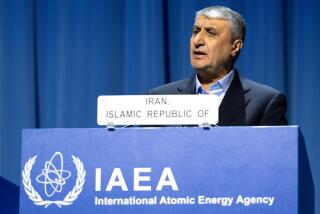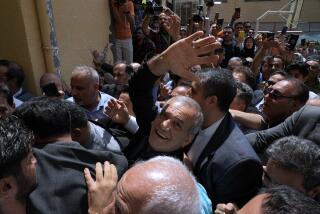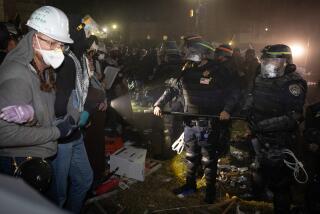Young, working-class and fed up: Iran’s deadly protests driven by a new crop of dissenters
- Share via
Reporting from TEHRAN — The 28-year-old university graduate stood in front of a bookstore window in central Tehran, pretending to browse the titles on the shelves. He really was looking out for Iranian security forces sent to quash anti-government protesters.
Kambiz, who gave only his first name, earned a physics degree but is among the millions of young Iranians who lack a steady job. For the past several nights, he has joined demonstrators in the side streets near Tehran University, chanting slogans to bring down the theocracy in the most significant unrest in Iran in nearly a decade.
“There is no future for me, let alone for millions of high school or college graduates,” said Kambiz, who has never voted in an election. “I don’t care about politics or domestic or foreign policy or the nuclear deal. I just need a predictable future.”
Iran’s economy has continued to sputter despite the 2015 nuclear agreement that eased international sanctions, and its leaders are increasingly seen as making things worse — tolerating corruption while supporting costly proxy wars overseas. The resulting public frustration has bubbled over into six days of protests that have left at least 21 people dead, state TV reported Tuesday.
The rallies in more than two dozen cities appear to herald a new crop of Iranian dissenters: young and working-class, alienated from a political system rigged by the ruling mullahs but connected through social media and filled with expectations for their own futures.
It is difficult to get a clear picture of the unrest; the Iranian government closely monitors journalists and allows foreign reporters outside Tehran only selectively. Most news and images from the protests, particularly beyond the capital, have come through Telegram and other Internet messaging apps and are difficult to verify.
But analysts say the protests — which began in the provinces before reaching Tehran — are being driven by working-class Iranians who are expressing an anger that seems sharper than in the last major political uprising in 2009. Demonstrators have chanted, “Death to the dictator,” meaning Iran’s supreme leader, and some have even called for a return to the monarchy that ruled before the 1979 Islamic Revolution that brought the clerical establishment to power.
“This is a much broader and deeper disavowal of the regime as a whole,” said Ali Ansari, founding director of the Institute for Iranian Studies at St. Andrews University in Scotland.
“If 2009 was a very middle-class rebellion, this is much cruder than that and much angrier than that. This is simpler folk, people who are basically fighting to make a living every day and have very basic demands.”
Iran’s leaders have painted the unrest as a foreign plot. Supreme Leader Ayatollah Ali Khamenei broke his silence on the protests Tuesday, saying that “Iran’s enemies, using the various tools at their disposal, including money, weapons, politics, and security apparatus, have allied [with one another] to create problems for the Islamic establishment.”
The speed and geographic spread of the rallies have surprised not only the mullahs but also veterans of Iran’s mainstream political reform movement, forged in the crucible of a disputed 2009 election that many of today’s protesters were too young to have voted in. A Tehran police official said this week that 90% of those arrested in the first five days of rallies were younger than 25.
A 25-year-old working in his father’s grocery shop in Tehran, who asked to be identified only as Saeed, sounded despondent when asked why he was protesting.
“Tell me what my future is,” the high school graduate said in a near-whisper, elbows propped on the counter. “I am a burden on my family. I’m not able to earn enough money. Tell me what else to do.”
The unrest began Thursday in the northeastern city of Mashhad, one of Iran’s most conservative cities. Hard-liners organized a rally against President Hassan Rouhani, a moderate cleric, that quickly expanded into a critique of the entire ruling system.
“It got out of hand because the actual societal discontent cannot be channeled against a particular faction — it is structural,” said Rouzbeh Parsi, an Iran scholar at Lund University in Sweden. “No matter who is running the country, it’s the same crap for people at the bottom.”
The 2009 uprising was centered in Tehran among educated, middle-class and politically engaged Iranians. Dubbed the “Green Movement,” those protests prompted a violent crackdown in which dozens were killed and thousands arrested. Authorities tortured prisoners and held Stalin-style show trials in which defendants were forced to confess they were foreign agents.
The shell of the Green Movement — whose leaders, former Prime Minister Mir-Hossein Mousavi and former parliamentary speaker Mehdi Karroubi, remain under house arrest — still carries the hopes of many reform-minded Iranian urbanites. When Rouhani campaigned for reelection last year, many in attendance at his rallies wore green armbands.
But some analysts say the movement stalled not only because of the clampdown but also because its vision for reform appeared to stop at the ballot box.
In nearly a decade since, Iran’s economy has been further hobbled by sanctions, corruption and mismanagement. Youth unemployment is believed to exceed 30%. The crash of oil prices has robbed Iran of its most reliable source of foreign exchange.
Rouhani’s promises that the nuclear agreement would help create jobs fell flat, and his attempts to impose austerity measures have slashed the subsidies on which many poorer Iranians had come to rely.
“The fact that many of the protesters don’t have the experience [of 2009] means they are willing in different ways to try it again,” Parsi said. “The demands are sharper because they’ve been cut to the bone economically much more than in 2009.”
At the same time, access to satellite television and the internet — although subject to controls — has raised the expectations of Iranians who live in areas outside Tehran and challenged the theocracy’s ability to shape public opinion.
Several years ago, Iranians nationwide were enthralled by a documentary series by a London-based satellite channel that lionized former monarch Reza Shah Pahlavi, whose son was deposed in the Islamic Revolution.
Senior government officials appear to be blaming the protests on various forms of interference from outside. The secretary of Iran’s Supreme National Security Council, Ali Shamkhani, said 27% of social media hashtags celebrating the protests were created by the Saudi government.
The U.S. has expressed open support for the demonstrators, calling for Iran to stop blocking social media platforms that allow them to communicate. President Trump chimed in again Tuesday on Twitter: “The people have little food, big inflation and no human rights,” he said. “The U.S. is watching!”
The current crop of protesters, lacking a leader or coherent message, have been greeted with skepticism by better-known critics of the establishment. Reihane Taravati, a social media activist in her 20s who gained notoriety in 2014 when she was arrested for participating in an online video inspired by the American pop song “Happy,” called the protesters “fishy and dubious.”
“My friends and I don’t identify with them,” Taravati said. “None of my many activist friends have any idea what or who the protesters are, what their agenda is, if they have any at all. Their slogans are weird.”
The authorities’ response suggests they are focused on neutralizing the protests but not addressing fundamental grievances.
“Even if this dies down, in a few days’ time or six months’ time, the regime has a problem, in that this discontent will simmer until they either take dramatic steps themselves or are forced to take them,” Ansari said.
“These protests are an awakening, although people have been waking up for some time.”
Special correspondent Mostaghim reported from Tehran and Times staff writer Bengali from Mumbai, India.
Follow @SBengali on Twitter
ALSO
Two killed in three days of stunning protests in Iran: What our correspondent saw
Trump’s backing of Iranian protesters could backfire as Tehran cracks down
Dogs, Deepak Chopra, Instagram weddings and other signs of change among Iran’s middle class
UPDATES:
1:40 p.m.: This article was updated with U.S. government reaction to the protests.
This article was originally published at 12:05 p.m.
More to Read
Sign up for Essential California
The most important California stories and recommendations in your inbox every morning.
You may occasionally receive promotional content from the Los Angeles Times.











